Yuhong Yang
Seed1.5-VL Technical Report
May 11, 2025Abstract:We present Seed1.5-VL, a vision-language foundation model designed to advance general-purpose multimodal understanding and reasoning. Seed1.5-VL is composed with a 532M-parameter vision encoder and a Mixture-of-Experts (MoE) LLM of 20B active parameters. Despite its relatively compact architecture, it delivers strong performance across a wide spectrum of public VLM benchmarks and internal evaluation suites, achieving the state-of-the-art performance on 38 out of 60 public benchmarks. Moreover, in agent-centric tasks such as GUI control and gameplay, Seed1.5-VL outperforms leading multimodal systems, including OpenAI CUA and Claude 3.7. Beyond visual and video understanding, it also demonstrates strong reasoning abilities, making it particularly effective for multimodal reasoning challenges such as visual puzzles. We believe these capabilities will empower broader applications across diverse tasks. In this report, we mainly provide a comprehensive review of our experiences in building Seed1.5-VL across model design, data construction, and training at various stages, hoping that this report can inspire further research. Seed1.5-VL is now accessible at https://www.volcengine.com/ (Volcano Engine Model ID: doubao-1-5-thinking-vision-pro-250428)
RayFlow: Instance-Aware Diffusion Acceleration via Adaptive Flow Trajectories
Mar 10, 2025



Abstract:Diffusion models have achieved remarkable success across various domains. However, their slow generation speed remains a critical challenge. Existing acceleration methods, while aiming to reduce steps, often compromise sample quality, controllability, or introduce training complexities. Therefore, we propose RayFlow, a novel diffusion framework that addresses these limitations. Unlike previous methods, RayFlow guides each sample along a unique path towards an instance-specific target distribution. This method minimizes sampling steps while preserving generation diversity and stability. Furthermore, we introduce Time Sampler, an importance sampling technique to enhance training efficiency by focusing on crucial timesteps. Extensive experiments demonstrate RayFlow's superiority in generating high-quality images with improved speed, control, and training efficiency compared to existing acceleration techniques.
Improving Speech Enhancement by Cross- and Sub-band Processing with State Space Model
Feb 22, 2025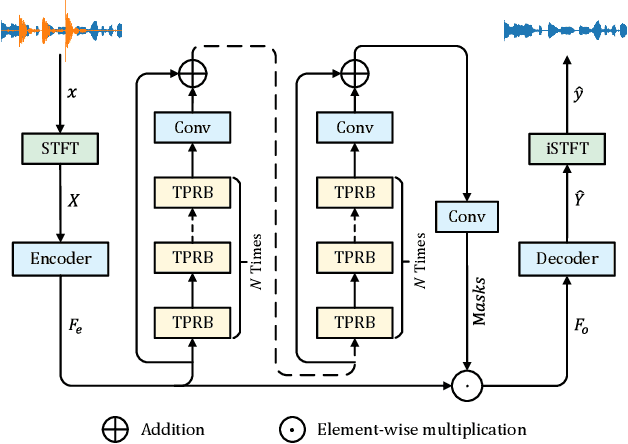
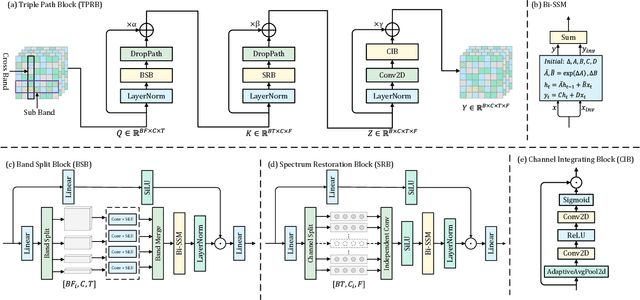

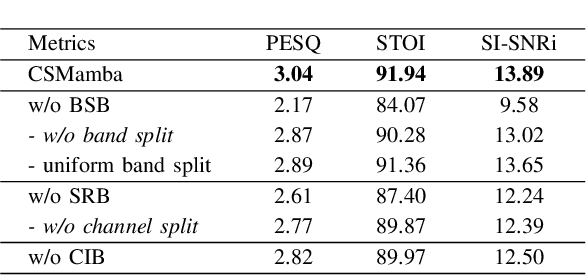
Abstract:Recently, the state space model (SSM) represented by Mamba has shown remarkable performance in long-term sequence modeling tasks, including speech enhancement. However, due to substantial differences in sub-band features, applying the same SSM to all sub-bands limits its inference capability. Additionally, when processing each time frame of the time-frequency representation, the SSM may forget certain high-frequency information of low energy, making the restoration of structure in the high-frequency bands challenging. For this reason, we propose Cross- and Sub-band Mamba (CSMamba). To assist the SSM in handling different sub-band features flexibly, we propose a band split block that splits the full-band into four sub-bands with different widths based on their information similarity. We then allocate independent weights to each sub-band, thereby reducing the inference burden on the SSM. Furthermore, to mitigate the forgetting of low-energy information in the high-frequency bands by the SSM, we introduce a spectrum restoration block that enhances the representation of the cross-band features from multiple perspectives. Experimental results on the DNS Challenge 2021 dataset demonstrate that CSMamba outperforms several state-of-the-art (SOTA) speech enhancement methods in three objective evaluation metrics with fewer parameters.
Model Privacy: A Unified Framework to Understand Model Stealing Attacks and Defenses
Feb 21, 2025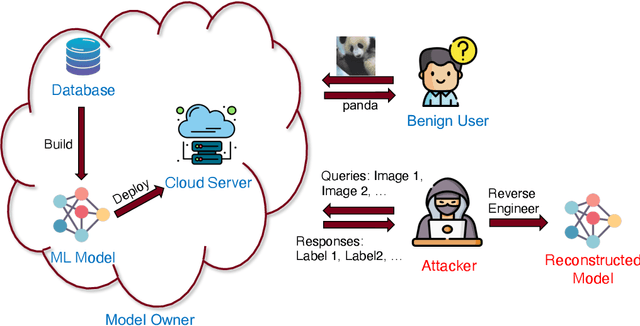
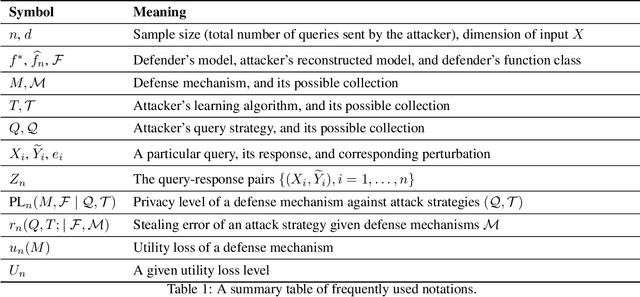
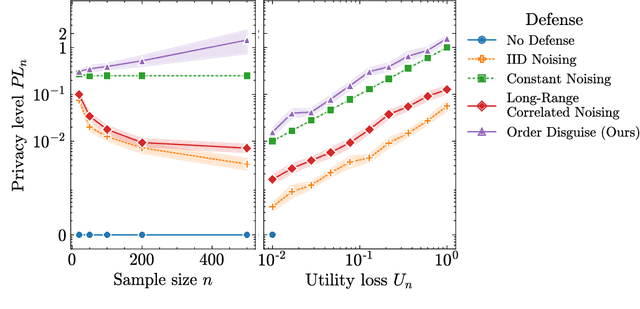

Abstract:The use of machine learning (ML) has become increasingly prevalent in various domains, highlighting the importance of understanding and ensuring its safety. One pressing concern is the vulnerability of ML applications to model stealing attacks. These attacks involve adversaries attempting to recover a learned model through limited query-response interactions, such as those found in cloud-based services or on-chip artificial intelligence interfaces. While existing literature proposes various attack and defense strategies, these often lack a theoretical foundation and standardized evaluation criteria. In response, this work presents a framework called ``Model Privacy'', providing a foundation for comprehensively analyzing model stealing attacks and defenses. We establish a rigorous formulation for the threat model and objectives, propose methods to quantify the goodness of attack and defense strategies, and analyze the fundamental tradeoffs between utility and privacy in ML models. Our developed theory offers valuable insights into enhancing the security of ML models, especially highlighting the importance of the attack-specific structure of perturbations for effective defenses. We demonstrate the application of model privacy from the defender's perspective through various learning scenarios. Extensive experiments corroborate the insights and the effectiveness of defense mechanisms developed under the proposed framework.
FreeCodec: A disentangled neural speech codec with fewer tokens
Dec 02, 2024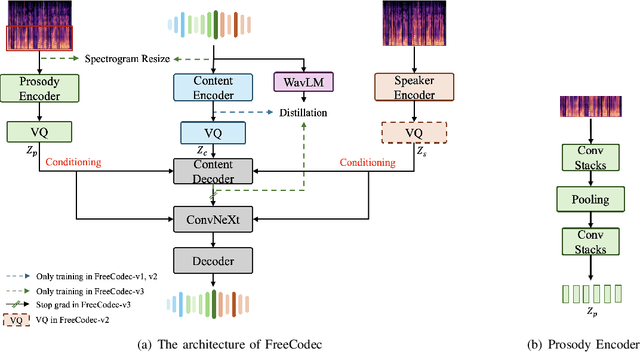
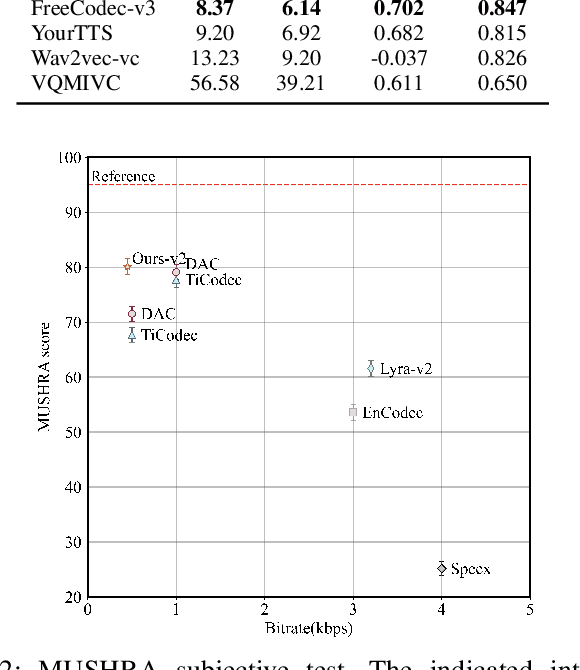

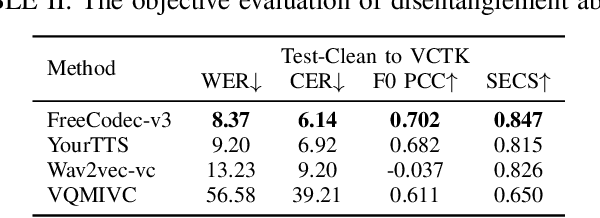
Abstract:Neural speech codecs have gained great attention for their outstanding reconstruction with discrete token representations. It is a crucial component in generative tasks such as speech coding and large language models (LLM). However, most works based on residual vector quantization perform worse with fewer tokens due to low coding efficiency for modeling complex coupled information. In this paper, we propose a neural speech codec named FreeCodec which employs a more effective encoding framework by decomposing intrinsic properties of speech into different components: 1) a global vector is extracted as the timbre information, 2) a prosody encoder with a long stride level is used to model the prosody information, 3) the content information is from a content encoder. Using different training strategies, FreeCodec achieves state-of-the-art performance in reconstruction and disentanglement scenarios. Results from subjective and objective experiments demonstrate that our framework outperforms existing methods.
Golden Ratio-Based Sufficient Dimension Reduction
Oct 25, 2024



Abstract:Many machine learning applications deal with high dimensional data. To make computations feasible and learning more efficient, it is often desirable to reduce the dimensionality of the input variables by finding linear combinations of the predictors that can retain as much original information as possible in the relationship between the response and the original predictors. We propose a neural network based sufficient dimension reduction method that not only identifies the structural dimension effectively, but also estimates the central space well. It takes advantages of approximation capabilities of neural networks for functions in Barron classes and leads to reduced computation cost compared to other dimension reduction methods in the literature. Additionally, the framework can be extended to fit practical dimension reduction, making the methodology more applicable in practical settings.
Minimax rates of convergence for nonparametric regression under adversarial attacks
Oct 12, 2024Abstract:Recent research shows the susceptibility of machine learning models to adversarial attacks, wherein minor but maliciously chosen perturbations of the input can significantly degrade model performance. In this paper, we theoretically analyse the limits of robustness against such adversarial attacks in a nonparametric regression setting, by examining the minimax rates of convergence in an adversarial sup-norm. Our work reveals that the minimax rate under adversarial attacks in the input is the same as sum of two terms: one represents the minimax rate in the standard setting without adversarial attacks, and the other reflects the maximum deviation of the true regression function value within the target function class when subjected to the input perturbations. The optimal rates under the adversarial setup can be achieved by a plug-in procedure constructed from a minimax optimal estimator in the corresponding standard setting. Two specific examples are given to illustrate the established minimax results.
Drift to Remember
Sep 21, 2024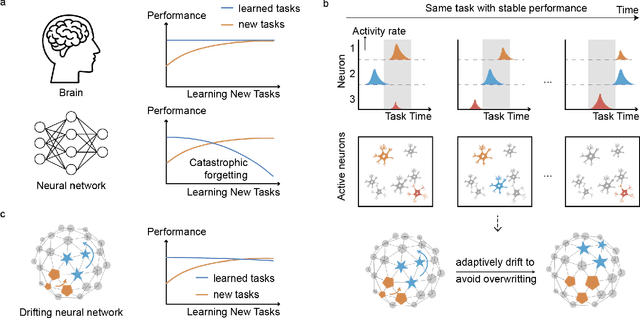
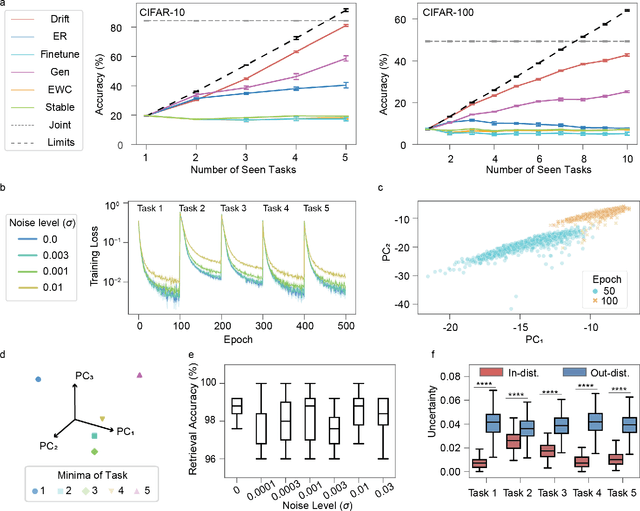
Abstract:Lifelong learning in artificial intelligence (AI) aims to mimic the biological brain's ability to continuously learn and retain knowledge, yet it faces challenges such as catastrophic forgetting. Recent neuroscience research suggests that neural activity in biological systems undergoes representational drift, where neural responses evolve over time, even with consistent inputs and tasks. We hypothesize that representational drift can alleviate catastrophic forgetting in AI during new task acquisition. To test this, we introduce DriftNet, a network designed to constantly explore various local minima in the loss landscape while dynamically retrieving relevant tasks. This approach ensures efficient integration of new information and preserves existing knowledge. Experimental studies in image classification and natural language processing demonstrate that DriftNet outperforms existing models in lifelong learning. Importantly, DriftNet is scalable in handling a sequence of tasks such as sentiment analysis and question answering using large language models (LLMs) with billions of parameters on a single Nvidia A100 GPU. DriftNet efficiently updates LLMs using only new data, avoiding the need for full dataset retraining. Tested on GPT-2 and RoBERTa, DriftNet is a robust, cost-effective solution for lifelong learning in LLMs. This study not only advances AI systems to emulate biological learning, but also provides insights into the adaptive mechanisms of biological neural systems, deepening our understanding of lifelong learning in nature.
Quantized Prompt for Efficient Generalization of Vision-Language Models
Jul 15, 2024Abstract:In the past few years, large-scale pre-trained vision-language models like CLIP have achieved tremendous success in various fields. Naturally, how to transfer the rich knowledge in such huge pre-trained models to downstream tasks and datasets becomes a hot topic. During downstream adaptation, the most challenging problems are overfitting and catastrophic forgetting, which can cause the model to overly focus on the current data and lose more crucial domain-general knowledge. Existing works use classic regularization techniques to solve the problems. As solutions become increasingly complex, the ever-growing storage and inference costs are also a significant problem that urgently needs to be addressed. While in this paper, we start from an observation that proper random noise can suppress overfitting and catastrophic forgetting. Then we regard quantization error as a kind of noise, and explore quantization for regularizing vision-language model, which is quite efficiency and effective. Furthermore, to improve the model's generalization capability while maintaining its specialization capacity at minimal cost, we deeply analyze the characteristics of the weight distribution in prompts, conclude several principles for quantization module design and follow such principles to create several competitive baselines. The proposed method is significantly efficient due to its inherent lightweight nature, making it possible to adapt on extremely resource-limited devices. Our method can be fruitfully integrated into many existing approaches like MaPLe, enhancing accuracy while reducing storage overhead, making it more powerful yet versatile. Extensive experiments on 11 datasets shows great superiority of our method sufficiently. Code is available at https://github.com/beyondhtx/QPrompt.
Improving Speech Enhancement by Integrating Inter-Channel and Band Features with Dual-branch Conformer
Jul 11, 2024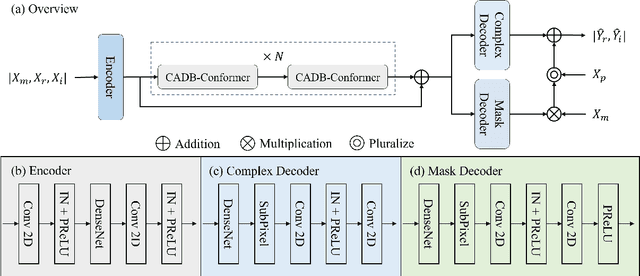


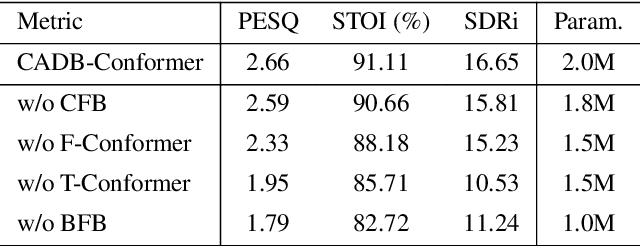
Abstract:Recent speech enhancement methods based on convolutional neural networks (CNNs) and transformer have been demonstrated to efficaciously capture time-frequency (T-F) information on spectrogram. However, the correlation of each channels of speech features is failed to explore. Theoretically, each channel map of speech features obtained by different convolution kernels contains information with different scales demonstrating strong correlations. To fill this gap, we propose a novel dual-branch architecture named channel-aware dual-branch conformer (CADB-Conformer), which effectively explores the long range time and frequency correlations among different channels, respectively, to extract channel relation aware time-frequency information. Ablation studies conducted on DNS-Challenge 2020 dataset demonstrate the importance of channel feature leveraging while showing the significance of channel relation aware T-F information for speech enhancement. Extensive experiments also show that the proposed model achieves superior performance than recent methods with an attractive computational costs.
 Add to Chrome
Add to Chrome Add to Firefox
Add to Firefox Add to Edge
Add to Edge